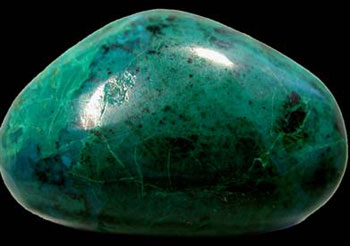'Amulet' blue stone in Egyptian mummy
Ancient Egyptians believed that colors had sacred power, when many times discovered green stones were wrapped in mummies of children.
One of the most recent evidences related to a 18-month-old Badarian mummy, existed for 4,500 years to 3,800 years BC.
The archaeologists' findings help explain why the pictorial texts in history say that Egyptian children often colored green.
It also adds to the evidence that the ancient Egyptians thought the color that preserved mystical energy had an impact on people even when they were alive and dead.

A sample of green stone is found in Egyptian mummies.
Raffaella Bianucci, working at the Department of Animal-Animal Biology, Via Accademia Albertina Academy in Turin, Italy, said: 'The existence of "talismans" (green stones) shows, very early, Ancient Egyptian people were conscious of controlling what they deemed unfortunate by mysterious methods. "
She and her colleagues radiated intense X-rays to analyze the composition of the stone. The results show that the stone is actually a crizocola mineral, or silicon copper hydrate. Today, crizocola is still used as a decorative stone.
Bianucci explains: 'In ancient Egypt, color is considered to have an important role in the material components. In it, green is the color of the young trees and the growing crop, the color of precious papyrus to make paper. It is linked to health and prosperity '.
In chapter 30 of a book about ancient Egyptian funeral rules, it is said that there must be a beetle-shaped talisman made from green minerals placed in the hearts of mummies, Bianucci gives know more.
In addition in the conception of the Egyptians, red is the color of life and victory, white refers to the ultimate power and purity, black is the symbol of death and dark night, symbolic green For life, resurrection and yellow are the colors of eternity and immortality, like the sun and gold.
Talking about the mummy's green amulet, Bianuccia said: "Maybe parents want their children to be protected from bad things and be healthy so they put them on them."
Salima Ikram, an Egyptian professor at the university, said the study sheds light on the customs and beliefs of ancient Egyptians.
'In fact, it is very interesting to discover children buried with a crizola because there is rarely such a discovery. Obviously this is a charm that has been placed with the child to make sure it will be safe, unfortunately it did not protect the child in this case, " Ikram said.
- Study 2,500 year mummy of 14-year-old boy
- New discovery about 2300-year-old Egyptian mummy
- Egyptian girl mummy full of jewelry
- Egyptian mummy wearing an intact mask after more than 1,600 years
- Add new findings from ancient Egyptian mummies
- Egyptian mummy 3,000 years of eternal rest by the people of today
- Inside the 3,400-year-old mummy coffin just opened in Egypt
- Decode the mystery of the Egyptian mummy collar
- The screaming mummy was intriguing in the Egyptian tomb
- Two-headed mummy sows fear in the Sultanate palace
- Mummy of 5-month-old fetus in tiny coffin
- Mummy has brain, no heart
 Discovered an ancient centipede fossil 99 million years old
Discovered an ancient centipede fossil 99 million years old Discovered bat-like dinosaurs in China
Discovered bat-like dinosaurs in China Discovered a 200-year-old bronze cannon of the coast
Discovered a 200-year-old bronze cannon of the coast Discover 305 million-year-old spider fossils
Discover 305 million-year-old spider fossils